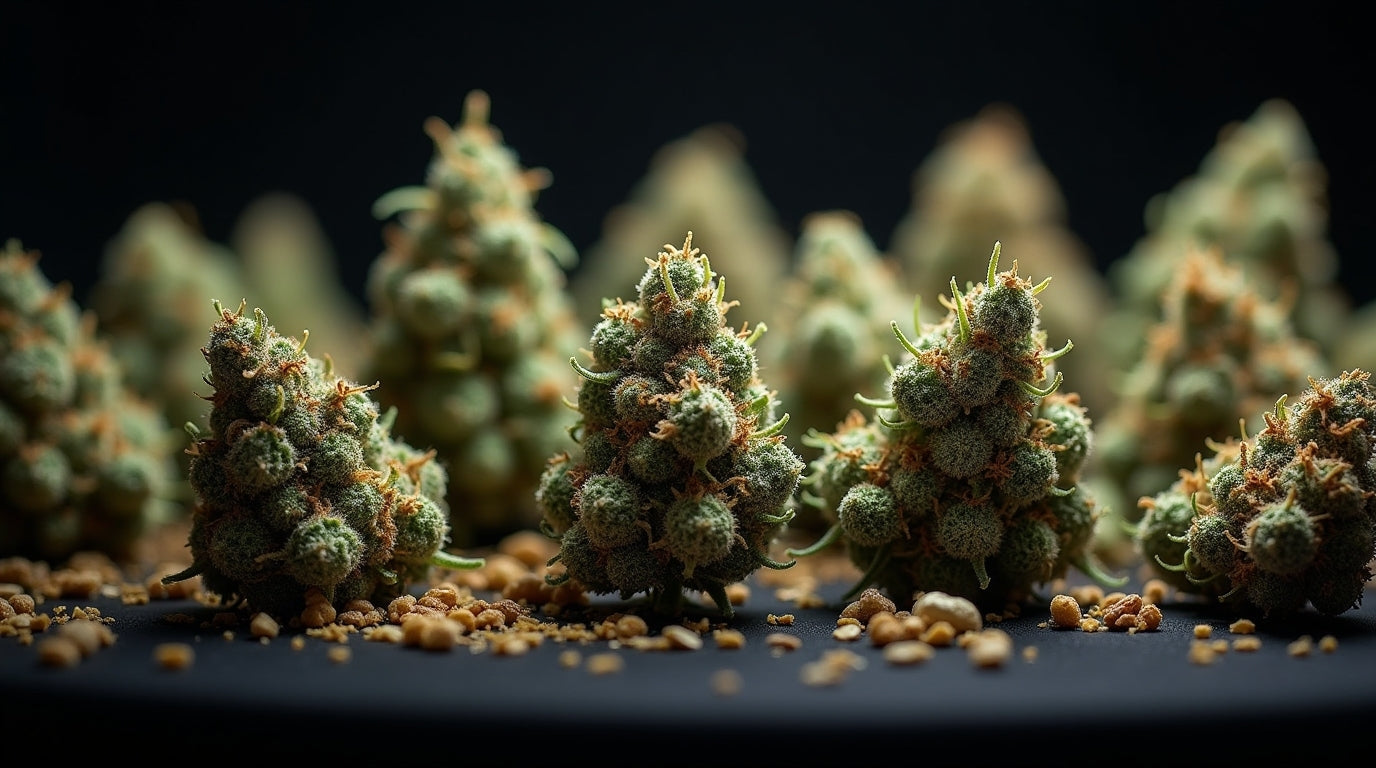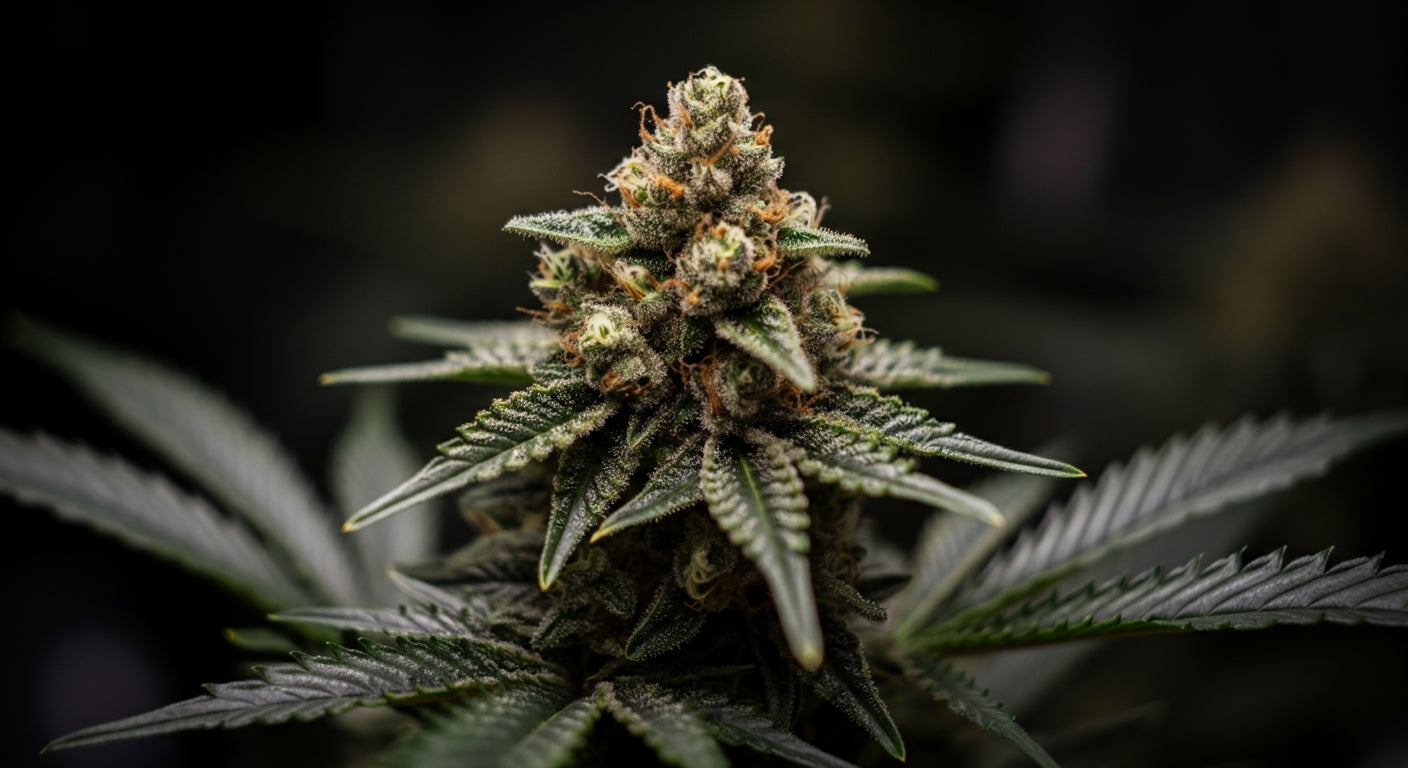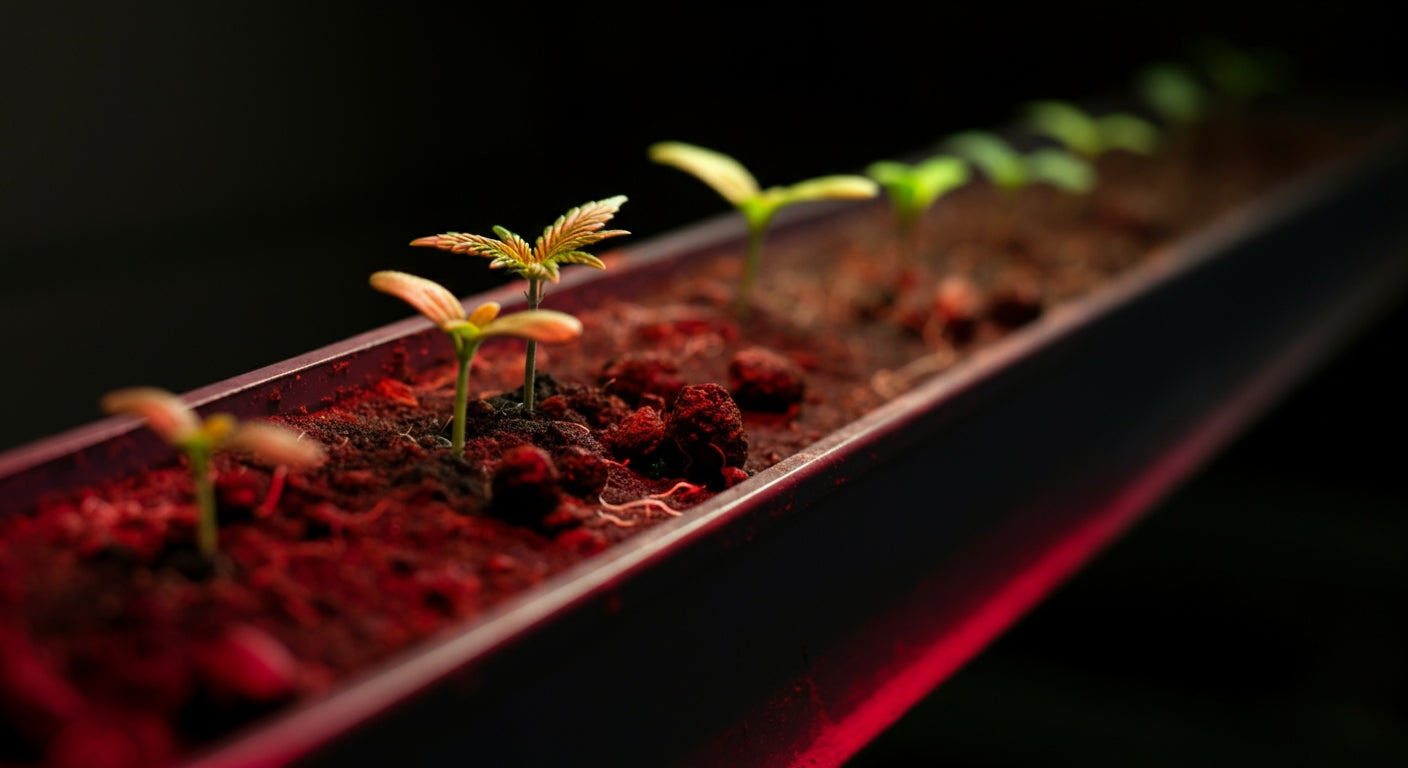
How to Grow Weed from Seed: Your Complete Guide from Germination to Harvest
Growing weed from seed offers the most rewarding cannabis cultivation experience, allowing you to witness the complete lifecycle from a tiny seed to a mature, resin-filled plant. Starting from seeds provides genetic diversity, potentially better root systems, and the satisfaction of nurturing plants from their very beginning.
While growing from seed requires more patience than starting with clones, the results often justify the extra time investment. Seeds produce robust plants with strong taproots, offering better resistance to environmental stress and potentially higher yields when grown properly.
This comprehensive guide will walk you through every step of growing cannabis from seed, ensuring you have the knowledge and confidence to produce exceptional harvests from your home garden.
Understanding Cannabis Seeds and Genetics
Types of Cannabis Seeds
Regular Seeds: Produce both male and female plants in roughly equal ratios. Ideal for breeding projects but require sexing and removal of males to prevent pollination.
Feminized Seeds: Genetically modified to produce only female plants, eliminating the need to identify and remove males. Perfect for growers focused on bud production.
Autoflowering Seeds: Automatically transition from vegetative to flowering stage based on age rather than light cycles. Great for beginners and faster harvests but generally produce smaller yields.
Photo-period Seeds: Require specific light schedules to trigger flowering, offering more control over plant size and timing but demanding strict environmental management.
Selecting Quality Cannabis Seeds
Quality genetics form the foundation of successful grows. Look for reputable seed banks that provide detailed strain information, including:
- Flowering time - How long from seed to harvest
- Expected yields - Potential harvest quantities
- Growing difficulty - Beginner vs. advanced cultivation requirements
- THC/CBD content - Cannabinoid profiles and potency levels
- Growth characteristics - Plant height, branching patterns, and space requirements
Fresh, viable seeds appear dark brown or black with smooth, hard shells. Avoid pale, cracked, or damaged seeds, which often indicate poor viability or improper storage.

Germination: The Critical First Step
How to Germinate Seeds Successfully
Proper germination sets the stage for healthy plant development throughout the entire grow cycle. Cannabis seeds require specific conditions to crack open and begin developing into seedlings.
Optimal Germination Conditions:
- Temperature: 70-85°F (21-29°C) for consistent warmth
- Humidity: 70-90% relative humidity to prevent drying
- Darkness: Seeds germinate best in complete darkness
- Moisture: Consistently damp but not waterlogged environment
- Oxygen: Adequate air circulation prevents anaerobic conditions
Paper Towel Germination Method
The paper towel method remains the most popular and effective technique for cannabis seed germination:
Step 1: Moisten paper towels with distilled water until damp but not dripping Step 2: Place seeds between towel layers, ensuring they don't touch each other
Step 3: Put the setup in a sealed plastic bag or container Step 4: Maintain temperature between 75-80°F (24-27°C) using a heat mat if necessary Step 5: Check daily for taproot emergence, typically within 24-72 hours
Once taproots extend 0.5-1 inch, carefully transplant to growing medium with taproot pointing downward.
Direct Soil Germination
Some growers prefer germinating directly in soil to avoid transplant shock:
Step 1: Fill small containers with seed-starting soil mix Step 2: Create 0.5-inch deep holes using your finger or pencil Step 3: Place seeds pointed-end down in holes and cover lightly Step 4: Mist soil surface to maintain moisture without overwatering Step 5: Maintain warm, humid conditions until seedlings emerge
This method reduces handling stress but makes monitoring germination progress more difficult.
Rockwool and Hydroponic Germination
For hydroponic growing systems, rockwool cubes provide excellent germination medium:
Step 1: Soak rockwool cubes in pH 5.5 water for 30 minutes Step 2: Insert pre-germinated seeds or place seeds directly in cube holes Step 3: Maintain high humidity dome environment Step 4: Provide gentle bottom heat and indirect lighting Step 5: Monitor for root emergence through cube bottom
Rockwool germination integrates seamlessly with hydroponic systems, eliminating transplant shock entirely.
Setting Up Your Growing Environment
Choosing the Right Grow Space
Starting from seed requires a controlled environment from day one. Gorilla Grow Tents provide optimal conditions for seed-to-harvest cultivation, offering precise environmental control and expandable height options.
For beginners growing from seed, a 2x4 grow tent kit provides perfect space for 2-4 plants while including all essential equipment. The kit approach eliminates guesswork and ensures compatibility between all components.
Essential Equipment for Seed-to-Harvest Growing
Lighting Systems: Cannabis grown from seed requires different lighting throughout its lifecycle. Xi LED grow lights offer full-spectrum lighting with adjustable intensities perfect for all growth stages.
Environmental Controls: Seedlings need higher humidity than mature plants, making adjustable environmental systems crucial. Quality ventilation prevents damping-off disease that commonly affects young seedlings.
Growing Medium: Whether choosing soil or hydroponic systems, consistency from germination through harvest simplifies plant care and maximizes results.
Week-by-Week Seedling Development
Weeks 1-2: Emergence and First Leaves
Days 1-7: Seeds crack and develop initial taproots. Cotyledon (seed) leaves emerge and begin photosynthesis.
Environmental Needs:
- Light: 18-24 hours of gentle lighting (200-400 PPFD)
- Temperature: 75-80°F (24-27°C) with minimal fluctuation
- Humidity: 65-75% to support delicate leaf development
- Watering: Light misting to maintain soil moisture without overwatering
Days 8-14: First true serrated leaves appear, indicating successful establishment. Root systems begin expanding rapidly.
Key Indicators of Healthy Development:
- Bright green coloration in new growth
- Sturdy stem development without stretching
- Root emergence from container drainage holes
- Active daily growth visible to naked eye
Weeks 3-4: Rapid Seedling Growth
Young plants accelerate growth rates while developing more complex leaf structures. This period requires transitioning from seedling to vegetative care approaches.
Environmental Adjustments:
- Light: Increase intensity to 400-600 PPFD while maintaining 18-hour photoperiod
- Temperature: Maintain 75-80°F (24-27°C) with good air circulation
- Humidity: Gradually reduce to 60-70% as plants strengthen
- Nutrients: Begin light feeding schedule if using soil amendments
Training Opportunities: Some growers begin gentle Low Stress Training (LST) during this period, though most prefer waiting until plants show more vigorous growth.

Vegetative Stage: Building Plant Structure
Weeks 5-12: Explosive Growth Period
The vegetative stage is when cannabis plants grown from seed really demonstrate their genetic potential. Plants can double in size weekly under optimal conditions.
Optimal Vegetative Conditions:
- Photoperiod: 18-24 hours of light daily
- Light Intensity: 600-900 PPFD for maximum photosynthesis
- Temperature: 75-85°F (24-29°C) during lights on, 65-75°F (18-24°C) lights off
- Humidity: 55-70% with excellent air circulation
- Nutrients: Higher nitrogen levels with complete micronutrient profiles
Plant Training Techniques for Seed-Grown Plants
Plants grown from seed typically develop stronger root systems and stems than clones, making them ideal candidates for training techniques:
Low Stress Training (LST): Gently bending and securing branches to create even canopies maximizes light exposure and increases yield potential. Seeds often respond better to LST than clones due to their natural vigor.
Topping and FIMing: Pruning techniques that encourage multiple main colas work exceptionally well with seed-grown plants. Their robust growth allows quick recovery from pruning stress.
Screen of Green (SCROG): Trellis netting combined with selective pruning creates uniform canopies perfect for maximizing yields in limited space.
Identifying Plant Sex
If growing regular (non-feminized) seeds, plants will reveal their sex during late vegetative stage or early flowering transition:
Male Plants: Develop pollen sacs that cluster at branch junctions. Remove immediately unless breeding is desired.
Female Plants: Show white pistils (hairs) emerging from tear-drop shaped calyxes. These develop into the resinous buds growers seek.
Hermaphrodite Plants: Display both male and female characteristics, usually due to environmental stress. Remove to prevent pollination of other plants.
Transitioning to Flowering Stage
Weeks 13-16: Initiating Bud Development
For photoperiod strains grown from seed, flowering begins when light cycles change to 12 hours light/12 hours darkness. This hormonal trigger causes dramatic physiological changes.
Pre-Flowering Preparation:
- Final Training: Complete all pruning and training before flower initiation
- Space Planning: Plants often double in height during flowering stretch
- Nutrient Transition: Gradually reduce nitrogen while increasing phosphorus and potassium
- Environmental Adjustments: Lower humidity to 40-50% to prevent mold issues
First Two Weeks of Flowering: Often called the "stretch period," plants can grow 12-24 inches while developing flower sites throughout the canopy.
Managing the Flowering Stretch
Plants grown from seed often exhibit more vigorous flowering stretches than clones, requiring careful management:
Height Control: Gorilla Grow Tents feature adjustable height extensions, providing extra vertical space when needed. The height extension kits can add 1-2 feet of growing space.
Light Distance: Maintain proper distance between LED grow lights and canopy to prevent light burn while ensuring adequate intensity.
Support Systems: Heavy bud development may require additional support using trellis netting or individual plant stakes.
Advanced Flowering Management
Weeks 17-25: Bud Development and Maturation
The flowering stage separates successful growers from those who struggle with poor yields or quality issues. Plants grown from seed often produce larger, more potent buds when environmental conditions remain optimal.
Critical Flowering Requirements:
- Strict Light Schedule: Any light interruption during dark periods can cause plants to hermaphrodite or revert to vegetative growth
- Optimal Temperature: 65-78°F (18-26°C) with cooler nighttime temperatures promoting resin production
- Controlled Humidity: 40-50% RH preventing mold while maintaining terpene development
- Enhanced Air Circulation: Increased airflow prevents moisture buildup in dense bud sites
Nutrient Management During Flowering
Understanding how plants get nutrients becomes crucial during flowering when nutrient demands shift dramatically:
Early Flowering (Weeks 1-3): Maintain moderate nitrogen levels while increasing phosphorus for flower site development
Mid Flowering (Weeks 4-6): Peak nutrient demands with emphasis on phosphorus and potassium for bud density and resin production
Late Flowering (Weeks 7-9): Reduce all nutrients gradually while monitoring trichome development for harvest timing
Flush Period (Final 1-2 weeks): Provide only pH-adjusted water to improve final product taste and burn characteristics

Harvest Timing and Techniques
Reading the Signs for Optimal Harvest
Plants grown from seed often have longer flowering periods than clones but typically produce superior yields and potency when harvested at peak maturity:
Trichome Examination: Use jeweler's loupe or digital microscope to examine trichomes on buds (not leaves):
- Clear trichomes: Too early, low potency
- Cloudy/milky trichomes: Peak THC, optimal harvest window
- Amber trichomes: THC converting to CBN, more sedative effects
Pistil Changes: White pistils turn orange/brown and recede into calyxes as plants mature
Overall Plant Appearance: Leaves yellow naturally as plants redirect energy to bud development
Harvesting and Initial Processing
Harvest Timing: Choose harvest window based on desired effects - earlier for energetic highs, later for relaxing effects
Cutting Technique: Use clean, sharp scissors to cut branches, handling buds minimally to preserve trichomes
Initial Trim: Remove large fan leaves immediately after cutting, leaving smaller sugar leaves for protection during drying
Drying and Curing for Maximum Quality
Proper Drying Environment
Environmental Conditions:
- Temperature: 60-70°F (15-21°C) for slow, even drying
- Humidity: 45-55% RH preventing mold while avoiding overdrying
- Air Circulation: Gentle airflow without direct exposure to buds
- Darkness: Complete darkness prevents THC degradation during drying
Drying Timeline: 7-14 days depending on bud density, environmental conditions, and desired moisture content
Curing Process for Premium Quality
Initial Cure (Weeks 1-4):
- Storage: Glass jars filled 75% full with loose-fitting lids
- Daily Monitoring: Check humidity levels and "burp" jars to release excess moisture
- Target Humidity: 58-65% RH using humidity packs if necessary
Extended Cure (Months 2-6):
- Reduced Monitoring: Open jars weekly rather than daily
- Flavor Development: Complex terpene profiles develop over extended curing periods
- Potency Optimization: THC-A slowly converts to more psychoactive THC
Troubleshooting Common Seed-Growing Challenges
Germination Issues
Low Germination Rates: Often caused by old seeds, improper storage, or suboptimal germination conditions. Always source fresh seeds from reputable suppliers and maintain consistent environmental conditions.
Damping-Off Disease: Fungal infection that kills seedlings, prevented by proper air circulation, avoiding overwatering, and maintaining clean growing environments.
Growth Stage Problems
Slow Growth: Usually indicates environmental stress, nutrient deficiencies, or root problems. Ensure optimal temperature, humidity, lighting, and root zone conditions.
Stretching: Excessive stem elongation caused by insufficient light intensity or improper spectrum. Increase light intensity and ensure proper distance from canopy.
Nutrient Deficiencies: Monitor plant appearance for deficiency symptoms and adjust feeding schedules accordingly. Plants grown from seed often have different nutrient requirements than clones.
FAQ Section
How long does it take to grow weed from seed to harvest?
Most photoperiod cannabis strains require 4-6 months from seed to harvest, including 2-4 weeks germination/seedling, 6-12 weeks vegetative growth, and 8-12 weeks flowering time depending on genetics.
What's the germination rate for quality cannabis seeds?
High-quality, fresh cannabis seeds typically have 80-95% germination rates when proper techniques are used. Lower rates often indicate old seeds or improper germination conditions.
Should I start with regular or feminized seeds?
Feminized seeds are ideal for beginners focused on bud production, eliminating the need to identify and remove male plants. Regular seeds offer genetic diversity and breeding opportunities but require more experience.
How many seeds should I germinate for my first grow?
Start with 2-3 more seeds than your target plant count to account for potential germination failures or male plants (if using regular seeds). A 3x3 grow tent can accommodate 2-4 plants grown from seed.
What's the advantage of growing from seed vs. clones?
Plants grown from seed develop stronger root systems, show better environmental resistance, and often produce higher yields than clones. Seeds also provide genetic diversity and the full growing experience from start to finish.
Summary
Bottom Line: Growing weed from seed provides the most rewarding cannabis cultivation experience, requiring patience during germination and early growth but delivering superior root development, genetic diversity, and potentially higher yields than clone-grown plants.
Success with seed growing depends on understanding each growth stage's specific requirements and maintaining consistent environmental conditions throughout the entire lifecycle. Quality genetics, proper germination techniques, and optimal growing conditions ensure the best possible results from your seed-to-harvest journey.
Start Your Seed-to-Harvest Journey Today
Transform cannabis seeds into premium harvests with professional equipment designed for complete growing cycles. Gorilla Grow Tent provides everything necessary for successful seed-to-harvest cultivation, from precise germination environments to complete growing systems.
Whether you prefer traditional soil methods or advanced hydroponic systems, our equipment ensures optimal conditions from germination through harvest. With height-adjustable grow tents, full-spectrum LED lighting, and lifetime growing support, you'll have everything needed to turn seeds into exceptional harvests.
Don't wait to start your seed-growing adventure. Browse our complete selection of grow tents and growing equipment to build the perfect setup for transforming quality genetics into premium cannabis. Join thousands of successful growers who trust Gorilla for consistently outstanding results from seed to harvest, every single grow cycle.

Lena Myles
I'm a mushroom enthusiast and home cook based in Oregon. I'm passionate about foraging and creating fungi-focused recipes, especially delicious, plant-based dishes using gourmet mushrooms like trumpet, shiitake, and oyster. When I’m not in the kitchen, you’ll usually find me wandering the woods in search of new wild flavors.


